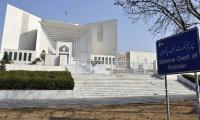KARACHI: Moody’s Investors Service on Wednesday warned Pakistan of downgrade risks to its credit outlook on fragile external account position, higher debt burden, weak infrastructure and political instability.
“Continued material widening of the fiscal deficit, ongoing weakening of the external payments position, loss of multilateral/bilateral financial support, or significant escalation in political tensions would weigh on Pakistan’s credit profile,” US credit rating agency Moody’s said in an opinion.
Moody’s that has assigned B3 stable to Pakistan said a stalling of government’s post-International Monetary Fund (IMF) program reform agenda, including revenue reforms, the strengthening of monetary policy and central bank independence, also pose risks to the credit outlook.
The credit rating agency, however, said strong growth performance and potential and stable banking sector could pave way for an improvement in the country’s credit profile.
“Upward triggers to the rating would stem from sustained progress in structural reforms that would significantly reduce infrastructure impediments and supply-side bottlenecks,” it added. “A lasting strengthening in the external liquidity position or meaningful reduction in the government deficit and debt burden would also be credit positive.”
Moody’s sees emanating pressures on external account from China-Pakistan Economic Corridor (CPEC) projects that albeit are expected to support growth projection of 5.5 percent in the current fiscal year of 2018 “could raise Pakistan’s debt burden more rapidly and significantly than we expect”.
“The economic benefits of CPEC are still highly uncertain and infrastructure impediments may continue to constrain growth to a greater extent than we currently envisage,” it added.
“In addition, the external payments position has deteriorated owing to high levels of imports and could develop into greater external vulnerability.”
Moody’s forecast FY2018 current account deficit at 3.5 percent of GDP.
The credit rating agency estimated government interest payment at 27.2 percent of GDP in the current fiscal year of 2018, which is forecast to increase at 29.5 percent during the next fiscal year, starting from July 1.
Moody’s forecast fiscal deficit at 5.5 percent of GDP in the current fiscal year as compared to 5.8 percent in the preceding fiscal year. The fiscal deficit is projected at five percent during the next fiscal year of 2019.
“Pakistan’s limited tax base restricts its fiscal space, while low savings and shallow capital markets hinder stable domestic financing of sizable budget deficits,” it said.
The credit rating agency said political risk remains high in Pakistan due to uncertainty arising from recent political developments and recurrent terrorist attacks.
“Events that could abruptly lead to negative pressure on Pakistan’s credit metrics relate to political shocks and the government’s large financing needs... political risk and government liquidity risk are the main drivers of our assessment of Pakistan’s ‘high’ susceptibility to event risk score,” it added.
Moody’s doesn’t foresee any impact of inclusion of Pakistan into grey list of the Financial Action Task Force’s grey list in June on borrowing from multilateral sources, which account for a significant portion of Pakistan’s external borrowing.
“We do not expect Pakistan’s addition to the grey list to have a material impact on its external financing,” it said. “Pakistan was previously on this list between 2012 and 2015 but managed to negotiate and enter into an IMF program during that time.”
US credit rating agency doesn’t anticipate the central bank to aggressively raise rates ahead of general elections as inflationary pressures remain modest despite strong domestic economy.
It projected consumer price inflation at 5.3 percent in FY2018 as compared to 3.9 percent in FY2017 and it is expected to inch down at 5.2 percent in FY2019.
Systems Limited, IT and IT-enabled services provider, hosted US Ambassador to Pakistan Donald Blome on May 3, 2024....
The logo of the Telenor Microfinance Bank . — temenos websiteKARACHI: Telenor Microfinance Bank reported a strong...
Chief Executive TDAP Mr. Zubair Motiwala met with HE Dr. Bakheet Ateeq Al-Remaiti, Consul General of UAE, in Karachi...
A representational image of gold bangles. — AFP/FileKARACHI: Gold prices in the local market dropped by Rs1,400 per...
A person walks by a sign advertising employment at a fast-food restaurant in New York City. — AFP FileWASHINGTON:...
This picture taken on January 30, 2023 shows residents buying vegetable at a market in Karachi. — AFP/FileLAHORE:...







